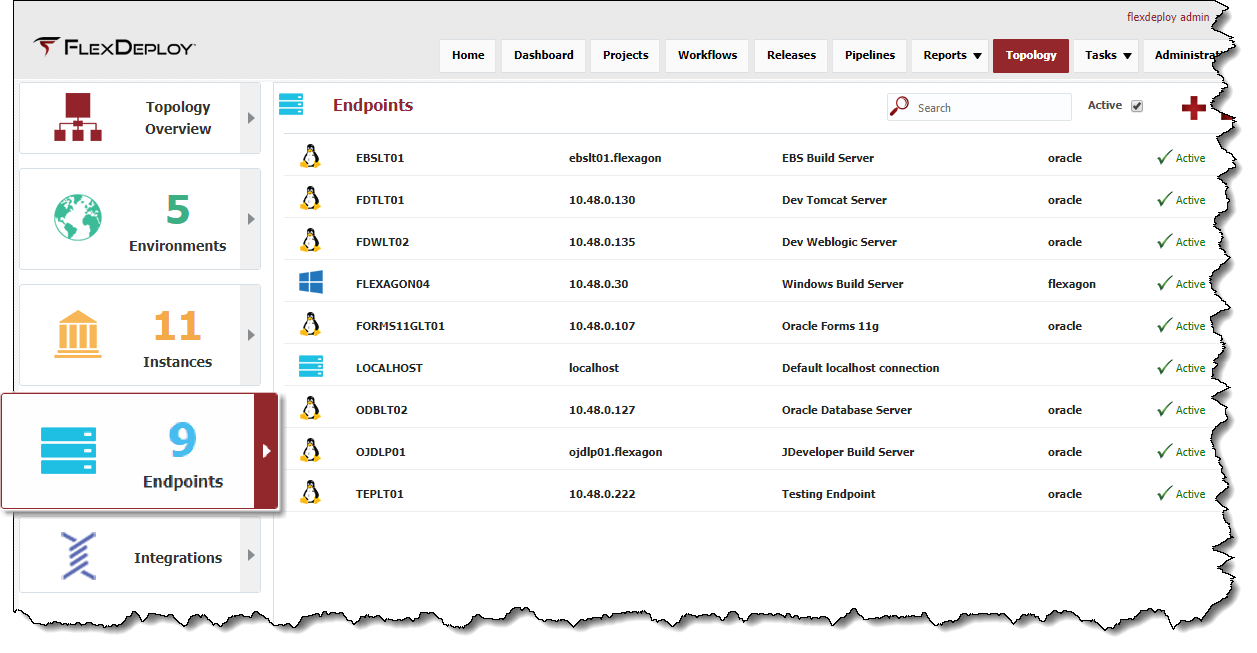Endpoints are the FlexDeploy representation of a device or virtual machine where plugins can be run. They hold connection and host details that allow FlexDeploy to connect to and perform commands on the server.
...
- Requires a Unix or Microsoft Windows operating system.
- Windows Server 2019 supports native OpenSSH
- For Microsoft other Windows , servers Cygwin must have Cygwin be installed , along with the openssh package. See the Cygwin Installation Guide for more information.
- Requires JDK 1.6 or higher to be installed.
- Requires a user account which FlexDeploy can connect with.
- Requires a directory which is writable by the user account that FlexDeploy connects with.
- The FlexDeploy server must be able to access the SSH port (default is port 22) on the Endpoint.
Viewing Endpoints
To view the configured Endpoints, select Topology -> Endpoints from from the menu, and then choose the Endpoints tab. Enter any optional search criteria and click the Search button.
Creating/Editing Endpoints
...
| Tip |
|---|
See Endpoint Defaults to setup default values for new Endpoints to save time. |
Activating and Inactivating Endpoints
To inactivate an Endpoint select an existing Endpoint and click the Inactivate button. The Endpoint will not be displayed if the criteria for Active is set to "No" click the Active link on the desired endpoint, and it will toggle to Inactive. This will hide that Endpoint after leaving the screen, until the Active checkbox is unchecked. To reactivate an Endpoint, select the desired Endpoint and click the Edit button. Then change the drop down menu for active to "Yes" and click Save. This Endpoint is now active in the system again and ready for use.click the Inactive link and it will toggle back to Active
Endpoint Directory Structure
...
work
The work directory contains every invocation of a plugin operation that has occurred on the Endpoint. There is additional file structure under the work directory based on the execution project id and the current execution id of the given project.<projectId>/<executionId>/temp
Directory for plugin execution to checkout and manipulate data or files until moved to the artifacts directory for storage.
<projectId>/<executionId>/artifacts
Directory where artifacts are stored so they can be transferred back to the FlexDeploy server and stored permanently in the artifact repository.
...
<projectId>/<executionId>/object-results
Directory utilized by partial deployment plugins to transfer the deployment status of each file back to the FlexDeploy server.
<projectId>/<executionId>/reports
Not currently utilized.
<projectId>/<executionId>/temp
Directory for plugin execution to checkout and manipulate data or files until moved to the artifacts directory for storage.
<projectId>/<executionId>/test-results
Directory for test plugins like Junit to place the test result to be processed.
<projectId>/<executionId>/transfer
Directory used to return file from a plugin execution and feed as input into another plugin operation. This directory is only used in very specific use cases.

